Visualizing the scope of the coronavirus

This past weekend New Hampshire officials announced a total of 60 deaths from COVID-19 in New Hampshire.
At one time the Institute of Health Metrics and Evaluation (IHME) at the University of Washington predicted over 300 deaths from coronavirus in New Hampshire. After New Hampshire shutdown non-essential businesses, the IHME cut that projection by more than half.
Meanwhile Massachusetts has seen close to 3,000 deaths and the U.S. has seen over 50,000.
So just how serious is the coronavirus pandemic? We put together some visualizations of the causes of death to help put coronavirus in perspective. (These charts are intended to help the public understand the scope of the pandemic and are in no way intended to represent a formal statistical analysis.)
Current deaths in New Hampshire
The following chart shows the weekly average cause of death in New Hampshire compared to the number of COVID-19 deaths reported in-state last week.
The average weekly cause of death is based on data from the Centers for Disease Control and Prevention (CDC). The latest data is from 2017. The weekly average is based on a whole year, so it doesn’t reflect seasonal differences. For example, there are more flu/pneumonia deaths in the winter than the summer. The new coronavirus also might ebb and flow with the seasons, but scientists say we don’t know that yet.
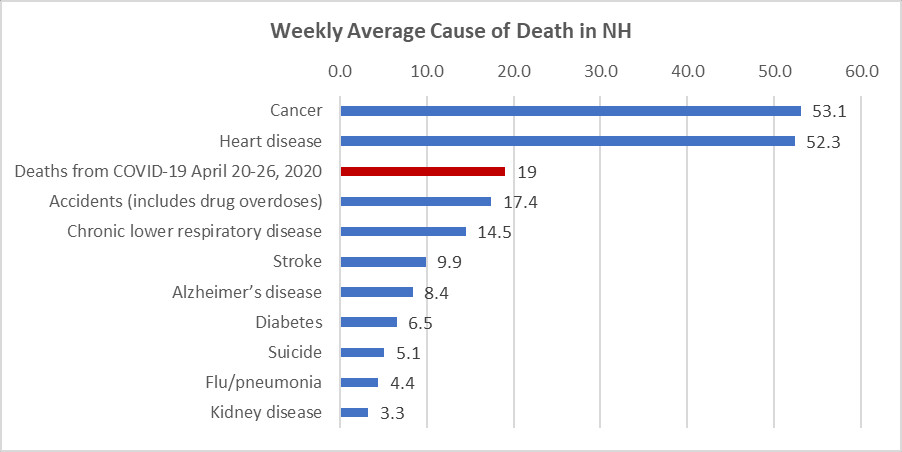
The chart shows that right now heart disease and cancer are still far more deadly in New Hampshire than coronavirus, but COVID-19 is roughly equivalent to the third leading cause of death. Last week New Hampshire saw the most deaths so far from COVID-19.
Total deaths in New Hampshire
The next chart shows the total yearly deaths in New Hampshire, using the same data from the CDC. The chart includes the total number of COVID-19 deaths in New Hampshire as of April 26, as well as the total deaths predicted by the IHME.
The IHME model predicts anywhere from 42 to 159 total deaths in New Hampshire. The model was last updated April 22, which means they have not incorporated the latest New Hampshire deaths. The model also only runs through August.
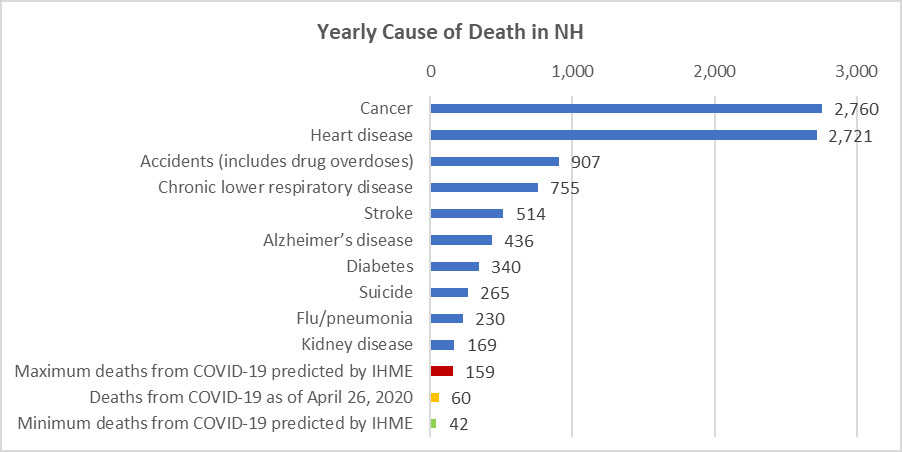
Right now it looks like COVID-19 deaths in New Hampshire may not even crack the top ten causes of death. Depending on your perspective, this means New Hampshire did a superlative job containing the virus, or hugely overreacted by shutting down the economy.
While it’s impossible to know what might have happened if New Hampshire stayed "open for business," the experience of other states and countries can give us an idea.
Current deaths in Massachusetts
Massachusetts is experiencing a much bigger disease outbreak than New Hampshire. This may be due to the Bay State’s much denser population; the disease also probably started spreading in Boston earlier than in the Granite State.
Still, our residents regularly travel back and forth over the border, weaving deep economic and social ties. On many occasions Gov. Sununu has referenced Massachusetts travelers as a factor in his decision to close parts of New Hampshire.
In short, Massachusetts offers a glimpse of what New Hampshire may have experienced if the disease spread further through the community.
The following chart shows the weekly average cause of death in Massachusetts compared to the number of COVID-19 deaths reported in the Bay State last week.
Once again the average weekly cause of death is based on 2017 data from the Centers for Disease Control and Prevention (CDC).
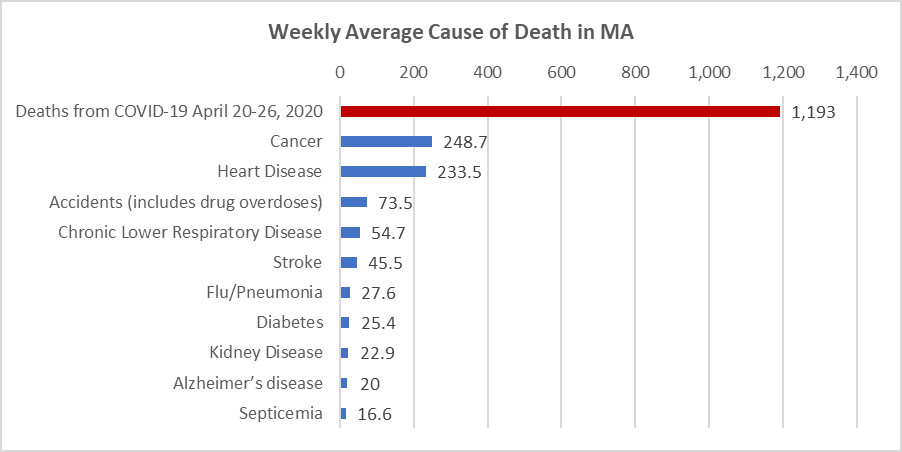
Right now COVID-19 looks much deadlier than anything else in Massachusetts. Last week had the most Massachusetts deaths from COVID-19 so far. It remains to be seen if this week will be better or worse.
Total deaths in Massachusetts
On April 26 Massachusetts reported 2,899 total deaths from COVID-19. Assuming the new coronavirus will decline as predicted this summer, the tragic number of deaths in Massachusetts will moderate. The April 22 IHME model predicts about 4,200 total COVID-19 deaths in Massachusetts by August—although there is a huge range of uncertainty, anywhere from 2,362 to 9,457.
The following chart uses the same 2017 data set from the CDC on yearly causes of death.
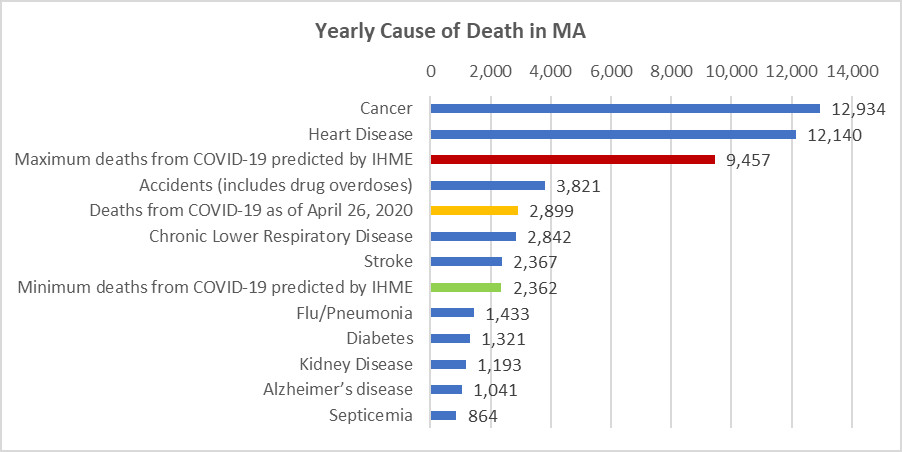
COVID-19 is shaping up to be the third leading cause of death in Massachusetts this year—far worse than in New Hampshire, but still well behind cancer and heart disease.
Current deaths in Sweden
As a final comparison, we’ll look at a different country: Sweden.
Sweden is getting a lot of attention right now because the government has not forced schools and businesses to close. Instead the government has taken a lighter touch, only encouraging people to socially distance, banning gatherings over fifty people, closing nursing homes to visitors, and limiting restaurants to seated customers.
Before comparing Sweden’s experience to New Hampshire’s, it’s important to remember the Granite State and Scandinavia are very different. Sweden has about seven times as many people as New Hampshire, but the country is more than eighteen times the size of the Granite State. That means Swedes are not as tightly packed as New Hampshirites.
Sweden’s population is also healthier than New Hampshire by several measures. For example, 30% of New Hampshire’s population is obese, compared to only 16% in Sweden.
Lastly, Sweden reported its first death from coronavirus on March 10, compared to March 23 in New Hampshire. Sweden is likely farther along the epidemic curve than the Granite State.
These differences mean Sweden’s approach could have a very different outcome in New Hampshire. Still, the country’s unique strategy is worth looking at because it is so different from the lockdown in New England.
The following chart shows the weekly number of COVID-19 deaths reported in Sweden over the past three weeks, compared to the average weekly cause of death. We included three weeks of data because it appears that Sweden may have already passed its peak of deaths, unlike Massachusetts and New Hampshire. The average weekly cause of death is calculated from 2017 data on the leading cause of death according to the Swedish National Board of Health and Welfare (Socialstyrelsen). Sweden uses somewhat different categories than the CDC, so the notes below the chart indicate some of the most common causes of death in both countries.
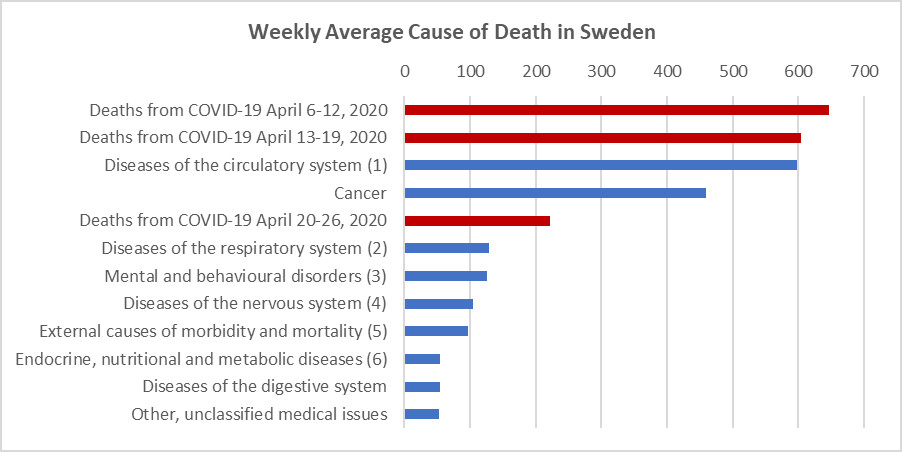
(1) Includes general heart disease
(2) Includes flu/pneumonia as well as chronic lower respiratory disease
(3) Includes dementia
(4) Includes Alzheimer’s disease
(5) Includes accidents, assaults, and suicide
(6) Includes diabetes
It appears that COVID-19 is very deadly right now in Sweden, but the current situation is not as dire as in Massachusetts.
Total deaths in Sweden
On April 26 Sweden reported 2,274 total deaths from COVID-19. The IHME model is predicting roughly 10,600 COVID-19 deaths in Sweden by August, but there’s a huge range of uncertainty, from a low of 2,700 deaths to a high of 42,661.
The following chart uses the same 2017 data from the Swedish National Board of Health and Welfare on yearly causes of death.
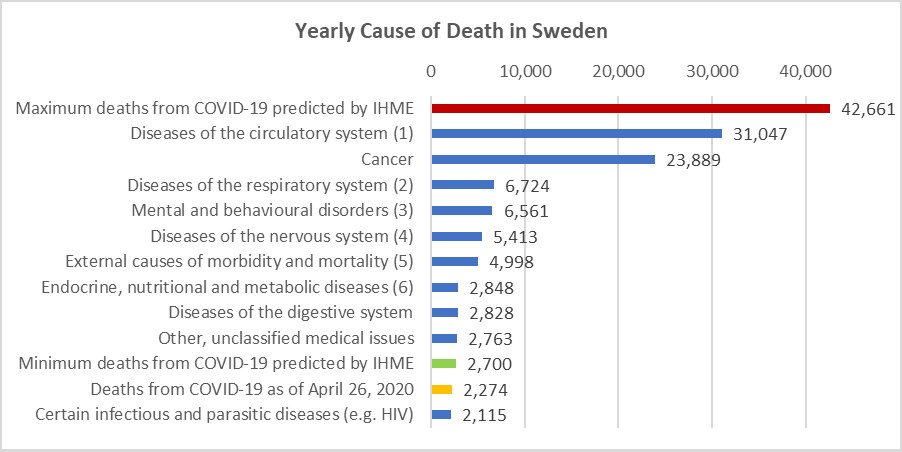
(1) Includes general heart disease
(2) Includes flu/pneumonia as well as chronic lower respiratory disease
(3) Includes dementia
(4) Includes Alzheimer’s disease
(5) Includes accidents, assaults, and suicide
(6) Includes diabetes
The low estimate of deaths from the IHME would barely put COVID-19 in the top ten causes of death in Sweden this year. However, if Sweden hits the high mark of that estimate, COVID-19 will be the number one cause of death in Sweden this year. Ultimately there is still huge uncertainty about how Sweden’s policies will impact the course of coronavirus in that country.
Still a lot of unknowns, but NH looking good
For now, with so much still unknown, it’s impossible to know the full scope of the coronavirus. Some antibody tests show that the disease may have already spread farther in our communities than we know, with many mild cases. However, scientists also say it’s possible that there will be another wave of coronavirus infections after we lift restrictions, or this fall, or next winter.
Acknowledging these uncertainties, it’s still fair to say that New Hampshire has not been overwhelmed by COVID-19 deaths so far—particularly compared to Massachusetts. Hopefully the IHME model is correct and it will not crack the top ten causes of death in New Hampshire this year.
Click here to see all of our resources related to COVID-19 in New Hampshire.











Comments
Login or register to post comments